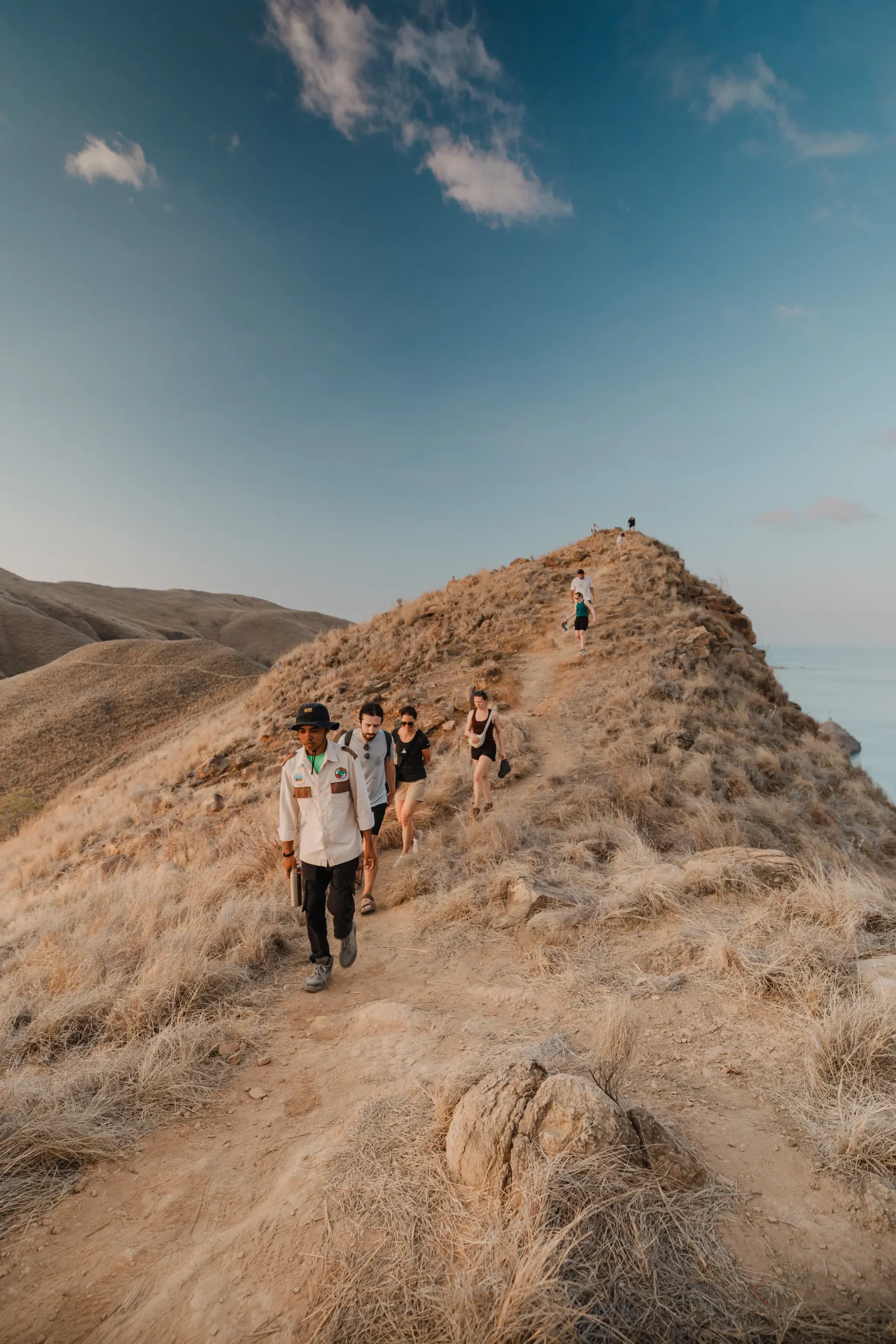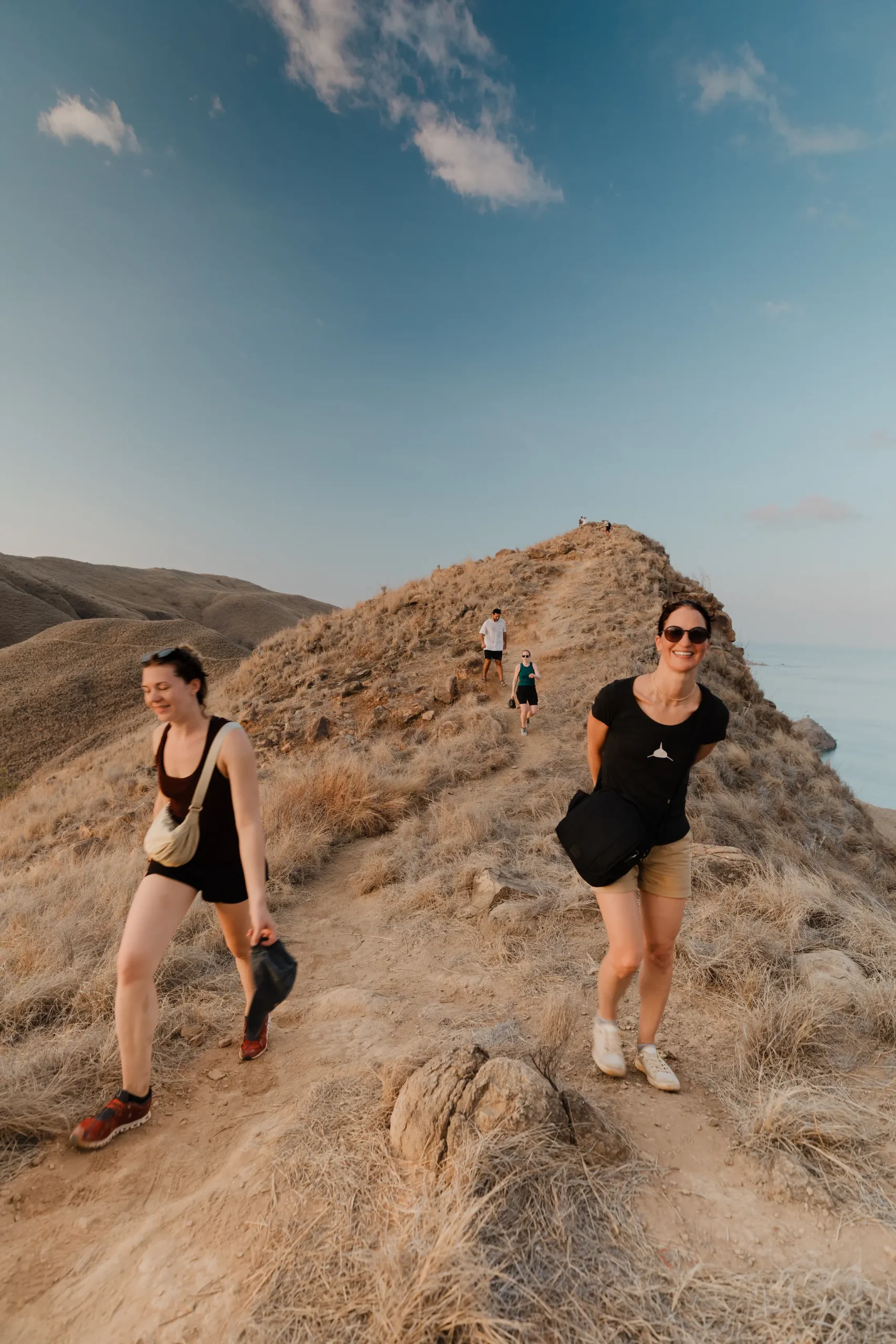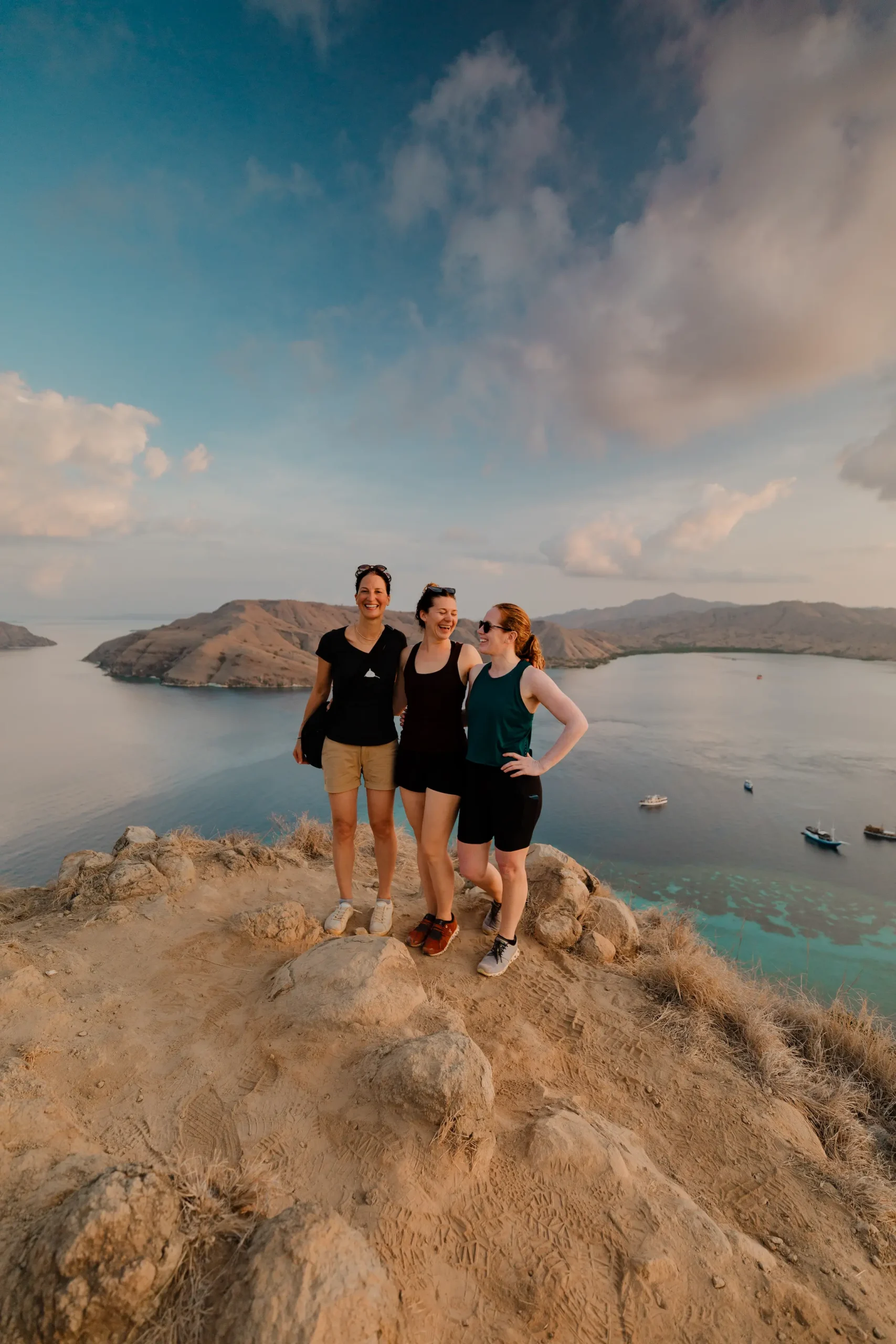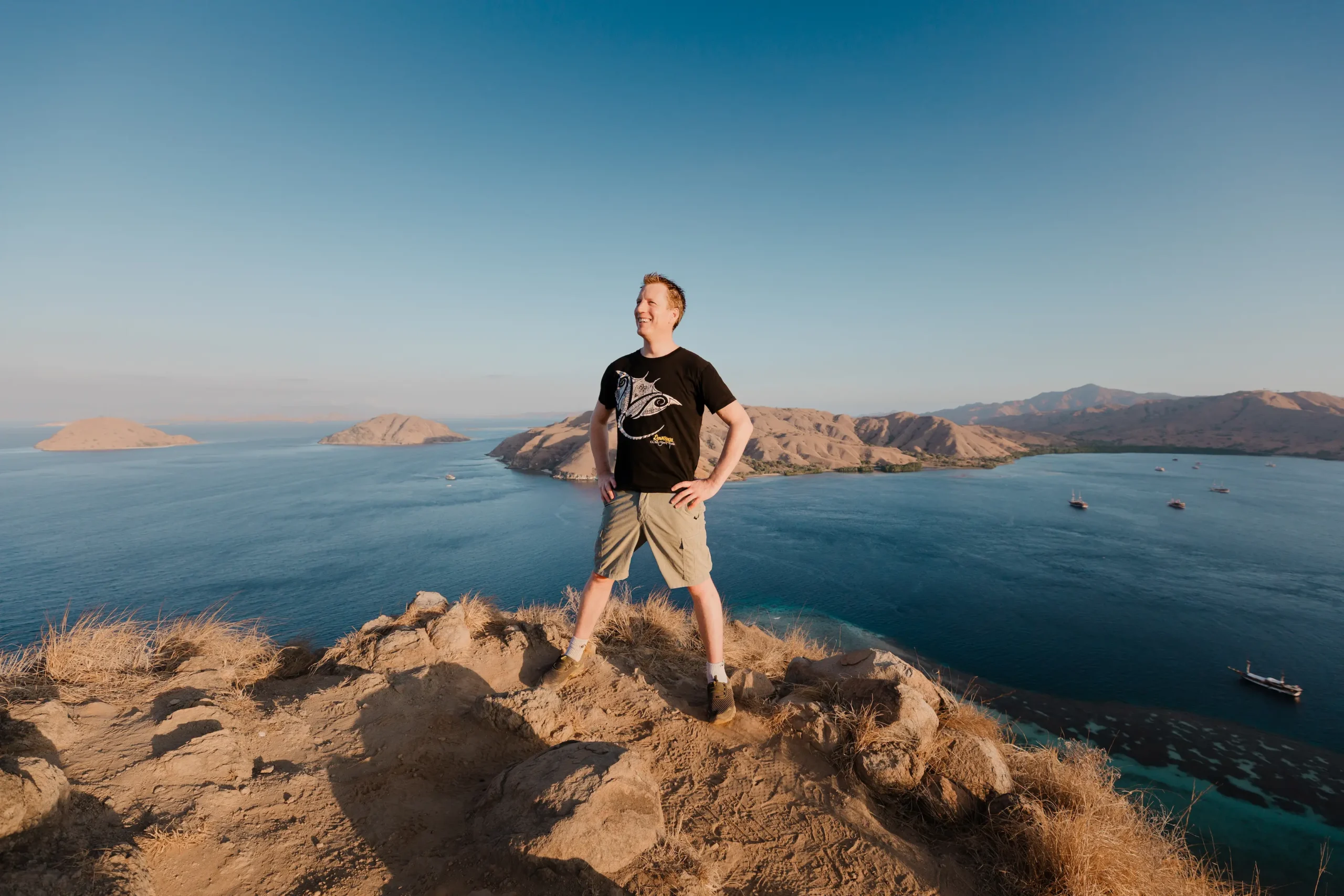Table of contents
- Gili Lawa at a Glance
- Where Are Gili Lawa Darat and Laut?
- Quick Facts: Gili Lawa, Komodo National Park
- Gili Lawa Darat: Rugged Beauty and Treks
- Gili Lawa Laut: Marine Marvel and Dive Haven
- The Golden Passage: Where Currents and Creatures Collide
- How to Visit Gili Lawa
- Conclusion
Gili Lawa: at a Glance
Gili Lawa is a pair of small islands located in the northern part of Komodo National Park. One is Gili Lawa Darat and the other is Gili Lawa Laut. Though they are often grouped together, these two islands are two distinct areas.
Both are known for their wide-open hills, beautiful views, and underwater life. These two islands are popular stops on liveaboard trips exploring the Komodo region.
But Gili Lawa isn’t your polished, umbrella-in-the-cocktail kind of paradise. It’s wild. Wind-scoured. The kind of place where your sweat earns the view, and the silence has weight. You come here to remember that nature doesn’t owe you comfort: only awe.
Where Are Gili Lawa Darat and Laut?
Gili Lawa Darat and Gili Lawa Laut sit in the northern part of Komodo National Park, just above Komodo Island itself. Though often spoken of as a pair, these are two distinct islands: divided not just by topography, but by water.
The Cauldron, also known as Shotgun, cuts between the two. It’s a narrow, high-velocity channel that grabs you, spins you, and spits you out the other side. Divers love it. Between Darat and Laut, this is the natural border: a line of turbulence and thrill.
To the west, the Golden Passage separates Gili Lawa Darat from the northeastern tip of Komodo Island. This is a broader strait, famous for drift dives where pelagic streams past and soft corals sway. Tidal timing here isn’t optional, it’s everything.
From the top of either island, you can see the whole northern end of the park stretch out before you; volcanic ridges, mirror-flat sea, and boats bobbing in hidden coves.
Terrain and Seasons
Gili Lawa’s terrain is textbook savannah: rolling, treeless hills that turn from emerald, green during the wet season (December to March) to dusty gold by the time July rolls around. It’s a dramatic shift, like someone turned up the contrast and swapped color palettes.
The hills of Darat are slightly more rugged and jagged, while Laut leans toward smoother, more rounded contours. But both offer sweeping, cinematic views and a sense of remoteness that’s hard to come by elsewhere in Komodo.
Quick Facts: Gili Lawa, Komodo National Park
- Location: Northern Komodo National Park, Indonesia, just north of Komodo Island, split into Gili Lawa Darat (land) and Gili Lawa Laut (sea).
- Best Time to Visit:
- Dry Season (April–November): Best for diving, snorkeling, hiking, and epic sunrises.
- June–July: Peak clarity and golden landscapes.
- Top Activities:
- Diving: Advanced-level drift dives at Castle Rock, Crystal Rock, The Cauldron, and Golden Passage.
- Snorkeling: Calm mornings, clear water, vibrant reef life.
- Hiking: Sunset and sunrise ridge treks on Gili Lawa Darat.
- Photography & Wildlife Watching: Savannah hills, reefscapes, deer, goats, boars, sea turtles, and birdlife.
- Liveaboard Cruising: Multi-day sea safaris with full access to dive and land sites.
Gili Lawa Darat: Rugged Beauty and Treks
Hiking Trails and Viewpoints
Trail Details: Distance, Difficulty Level, and Duration
The main trek on Gili Lawa Darat is a moderately challenging hike that takes approximately 45 minutes to an hour to reach the summit. The trail involves steep inclines and uneven terrain, requiring a reasonable level of fitness.
Best Times for Hiking: Sunrise and Sunset Views
The most rewarding times to undertake the hike in Gili Lawa Darat are during sunrise and sunset. These periods offer cooler temperatures and the opportunity to witness breathtaking views as the sun casts its hues over the landscape.
What to Expect: Terrain, Flora, and Fauna
Hikers can expect a trail composed of dirt paths and rocky sections. The flora is predominantly grasslands with sparse trees, and fauna includes sightings of deer and various bird species.
What is the trek like?
Trekking Gili Lawa Darat isn’t a casual stroll, but it’s not mountaineering either. The trail starts gently enough, a dusty path flanked by golden grass with the sea shimmering in the background. But soon, the incline kicks in. The dirt gets loose underfoot, the sun presses down, and your legs start to feel the climb.
It’s the kind of hike where you’ll want water, sturdy shoes, and a bit of grit. Wind often arrives late but welcome, cutting through the heat as you gain elevation. The final push to the summit rewards you with a sweeping, surreal panorama: the hills rolling like frozen waves, the reef-fringed bays below, and boats anchored in silence.
Gili Lawa Darat’s Summit wont be an easy climb, but it’s not meant to be. The payoff isn’t just the view, it’s knowing you earned it, step by dusty step.
Wildlife Spotting
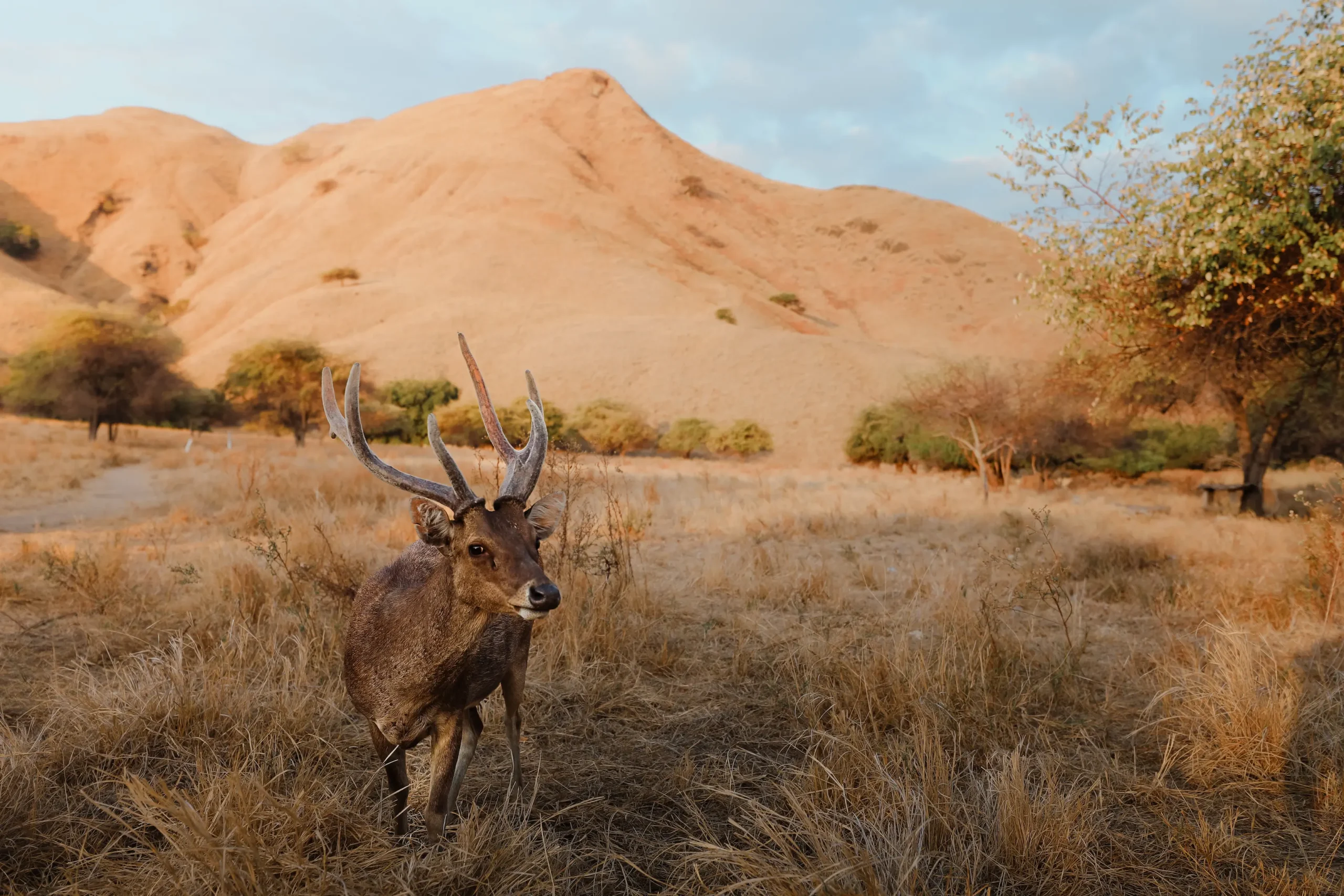
Komodo’s smaller creatures aren’t as famous as their dragon cousins, but they’re worth the attention. Look out for Timor deer grazing near the shoreline or silhouetted against the skyline. Death defying goats cling to the sides of high up rocky cliffs. Birdlife includes imperial pigeons, frigatebirds, and the occasional raptor gliding on thermals. Bring binoculars if you’ve got ‘em, or just keep your eyes open and curious.
Rangers on Gili Lawa Darat
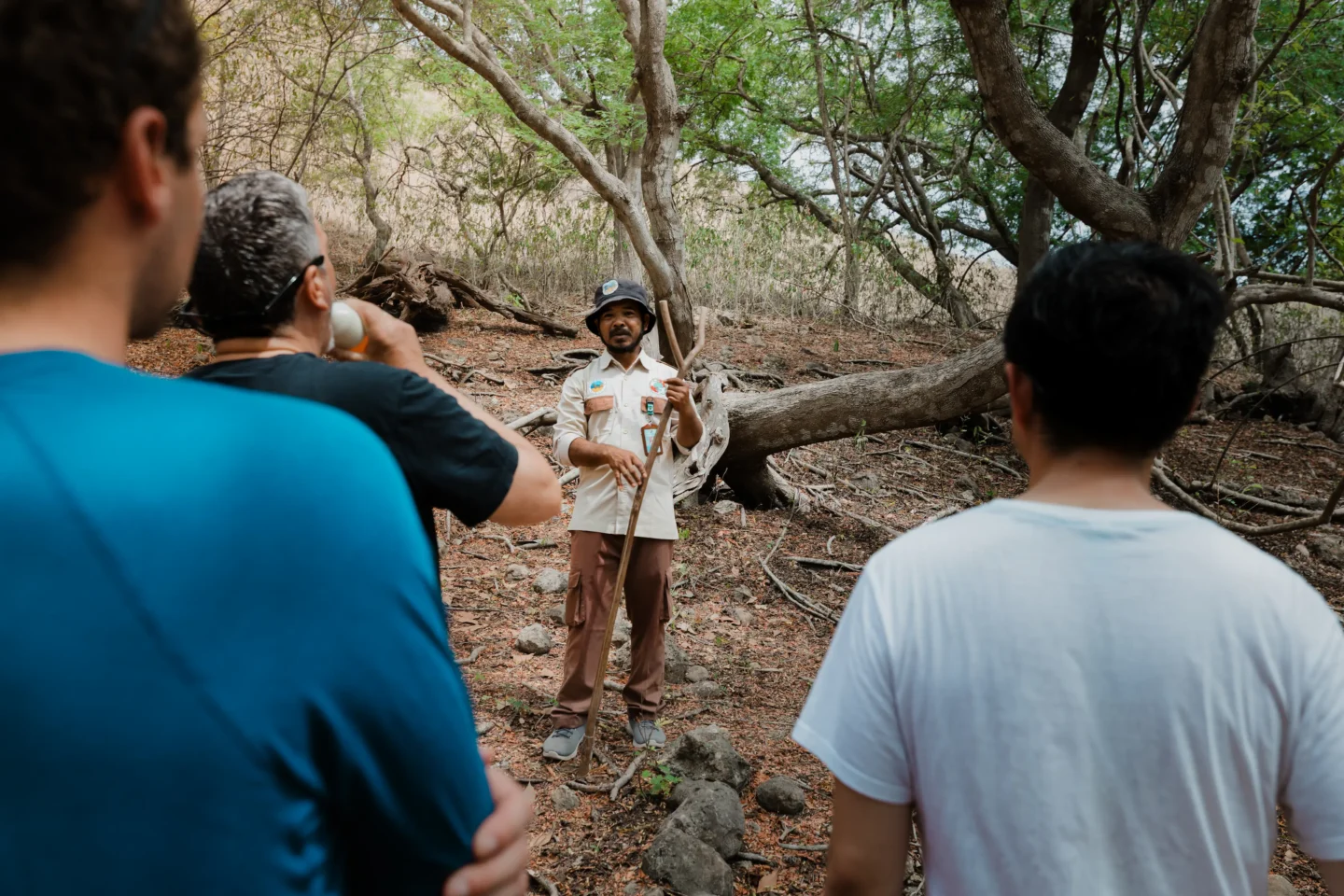
Gili Lawa Darat is patrolled by a small team of rangers from Komodo National Park. These rangers are responsible for monitoring illegal fishing activity, maintaining conservation boundaries, and ensuring that park rules are followed by tour operators and visitors.
The rangers live in basic huts near the shore and interact with visiting boats when necessary. The presence of the rangers also helps manage environmental impact, particularly as tourism in Komodo grows.
Furthermore, following a damaging fire in 2018, stricter regulations were enforced by park rangers. Visitors are now required to stick to marked trails and avoid any open flames or smoking.
Gili Lawa Laut: Marine Marvel and Dive Haven
Dive Sites Around Gili Lawa Laut
| Dive Site | Depth Range | Current Strength | Difficulty Level |
| Castle Rock | 66–98 ft (20–30 m) | Moderate to Strong | Advanced |
| Crystal Rock | 10–82 ft (3–25 m) | Strong (timing critical) | Advanced |
| The Cauldron | 16–82 ft (5–25 m) | Very Strong (Drift Dive) | Advanced (Expert Recommended) |
| Golden Passage | 39–82+ ft (12–25+ m) | Strong, Directional | Advanced |
A table of the best Dive Sites near Gili Lawa Laut
Castle Rock
Castle Rock is one of the signature dive sites in the Komodo region and a must-dive for experienced divers. This submerged seamount like a castle rising from the seafloor sits just northeast of Gili Lawa Laut and is known for its strong currents, excellent pelagic sightings, and dynamic fish life.
Crystal Rock
Just a short distance from Castle Rock, Crystal Rock is partially exposed at low tide and offers a stunning mix of hard and soft corals in crystal clear water. The top of the reef sits at 3–5 meters, ideal for shallow cruising and end-of-dive off-gassing.
Deeper zones range between 20–25 meters, where larger marine life can be found: Napoleon wrasse, sweetlips, batfish, and more. Currents can be strong here, often requiring a negative entry and drift positioning, so diving with an experienced guide is important.
Crystal Rock is best dived during slack tide or mild current windows to ensure safety and to avoid being swept too far from the main structure.
The Cauldron (Shotgun)
The Cauldron, also called Shotgun, is a natural channel dive that sits between Gili Lawa Laut and Gili Lawa Darat. The dive begins in a shallow bowl-like depression that gradually funnels into a narrow chute, where the real ride begins.
This is a high-adrenaline drift dive where divers are literally shot through a tight passage like unloading both barrels on a 12 gauge by powerful current. Along the way, expect to pass schools of jacks, barracuda, sweetlips, reef sharks, and occasionally even manta rays.
The Cauldron is suitable for advanced divers only, and dive planning must be timed precisely with tide cycles. Surface support is critical due to the unpredictable exit point and strong surface flow.
What It Feels Like, Diving Here
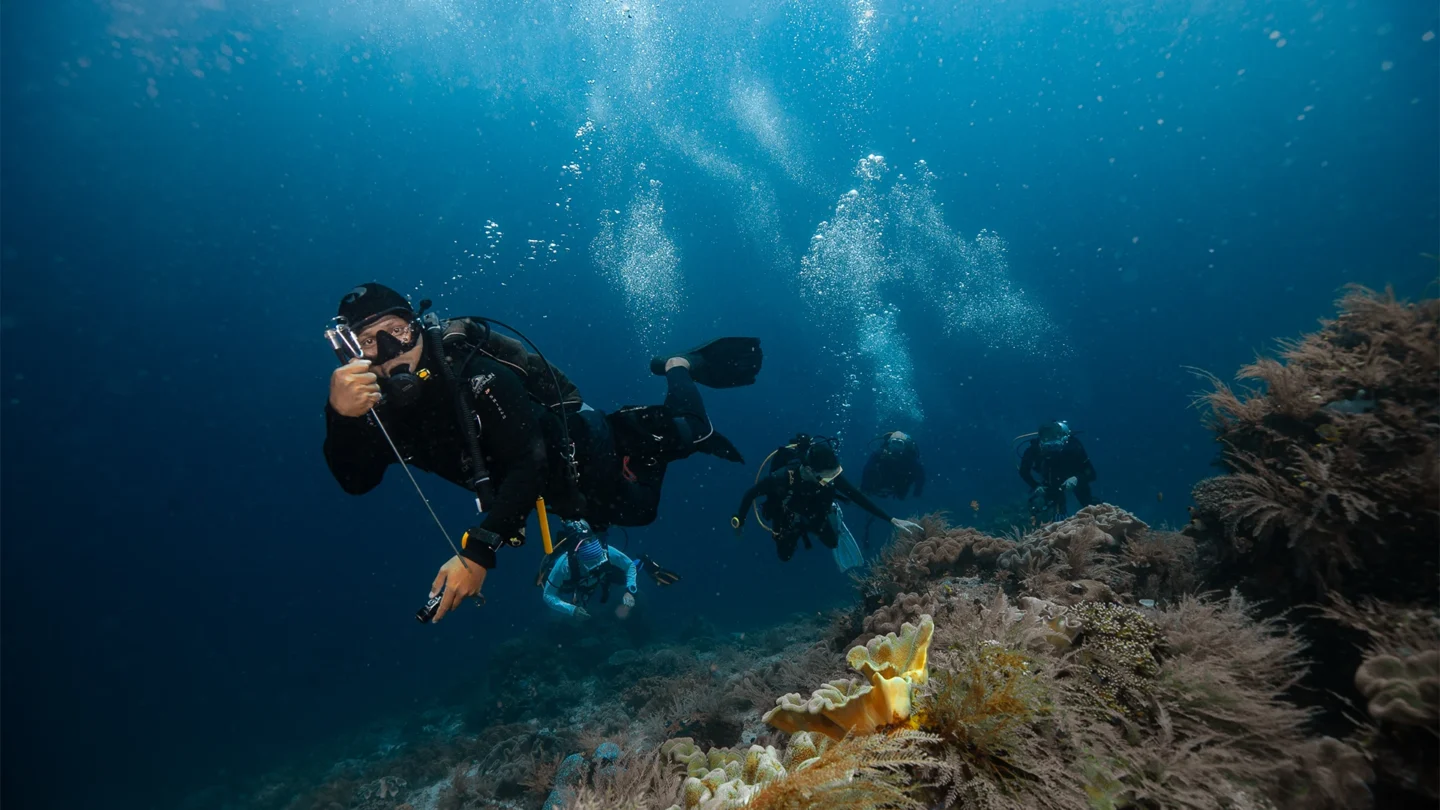
Castle Rock feels like you’re floating in the orchestra pit. The current holds you in place while marine life pours past like rush-hour traffic, each pass more dramatic than the last.
Crystal Rock dazzles in daylight, bright, layered, buzzing with life. It’s where you drop in and forget which way is up because the fish don’t care, they’re moving in every direction like confetti in a wind tunnel.
And The Cauldron? It earns its nickname. One second, you’re calmly hovering, the next you’re launched like a torpedo through a vortex of sharks and jacks, bursting out the other side like a champagne cork. You don’t dive Shotgun for the reef, you dive it for the thrill, and the laugh you and your buddy share when you break the surface, adrenaline still bubbling under your skin.
Snorkeling and Surface Activities
Snorkeling in Gili Lawa Laut is best done in the morning. Ideally between 6:00 and 10:00 a.m., when the water is calm, and visibility is at its peak. Afternoon winds can create surface chop, especially around the more exposed northern coastline.
Visibility typically ranges from 20 to 30 meters, with the clearest water during the dry season (April to November). Stick to leeward-facing reefs for safer conditions and better marine life encounters.
*This is the general rule of thumb. Conditions may vary depending on the season: consult your dive guide for real-time advice.
The Marine Life
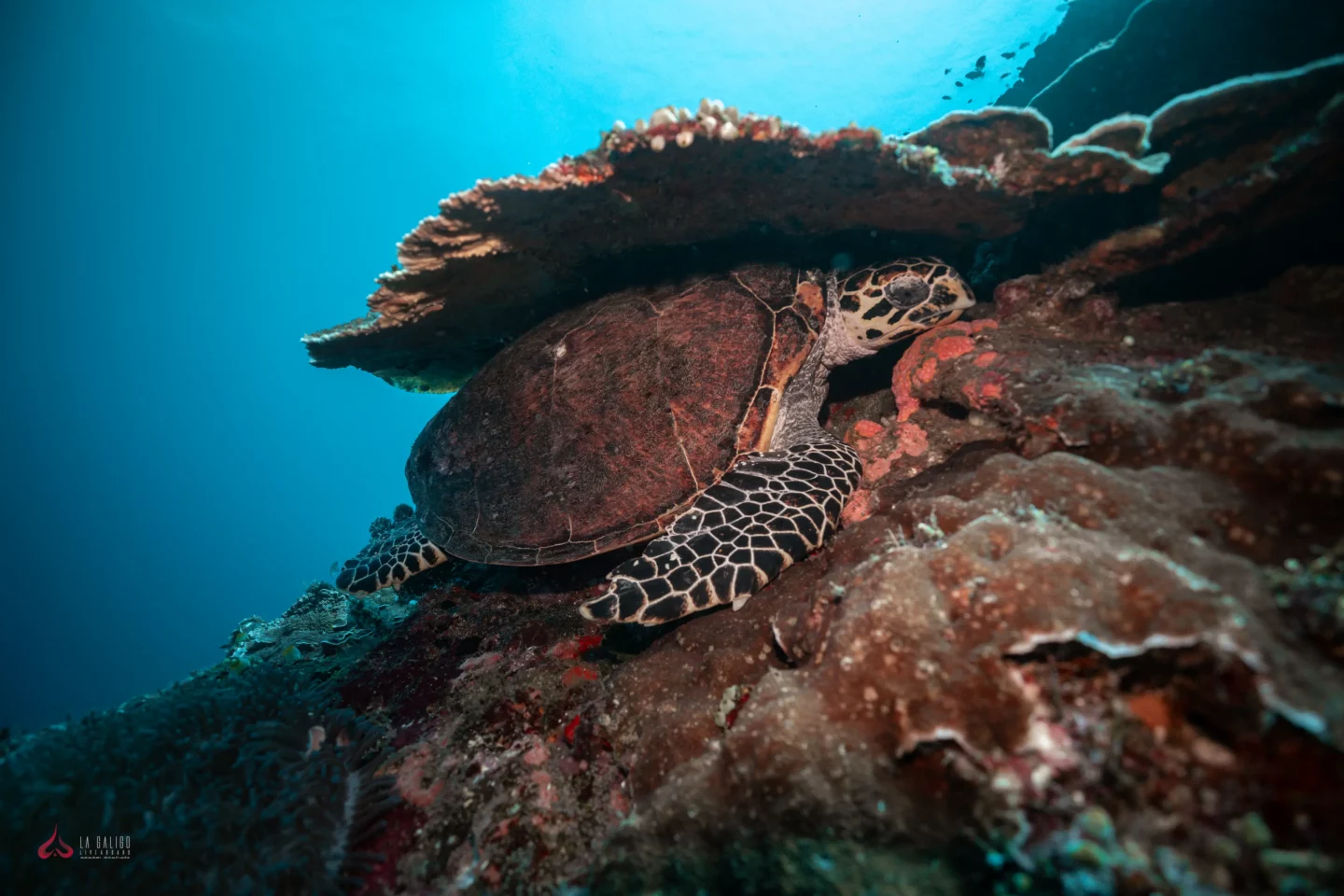
The area is known for its healthy reef systems and wide range of species. Snorkelers can expect to see:
- Green sea turtles
- Juvenile blacktip reef sharks
- Clownfish, bannerfish, parrotfish, and anthias
- Lots of Frogfish!
- Reef octopus and cuttlefish in crevices or shaded coral heads
- A mix of soft and hard corals, including staghorn, plate, and mushroom varieties
On rare occasions, manta rays are seen passing through deeper snorkel-accessible channels near reef drop-offs.
Equipment and Safety
Bring or rent high-quality snorkeling or diving gear, including a well-fitting mask and dry snorkel. Fins are recommended to navigate mild currents and cover wider areas comfortably.
Wear reef-safe sunscreen and a full-body rash guard or 2–3mm wetsuit for UV protection and sting prevention.
Always use the buddy system and inform your dive crew of your planned area. For deeper sites like Crystal Rock, boat support is essential for safety and pickup.
What It Feels Like, Snorkeling Here
If diving is full immersion, snorkeling here is suspended belief. You’re drifting across a marine tapestry, turtles nibbling through seagrass, anthias flaring in coral crevices like underwater fireworks, and cuttlefish morphing through colors as if dreaming out loud.
There’s no tank. No bubbles. Just you, your breath, and a world that has no reason to care about the surface you came from. And that’s the beauty of it, this isn’t second-rate diving. This is its own kind of magic, and once it gets in your head, good luck forgetting it.
The Golden Passage: Where Currents and Creatures Collide
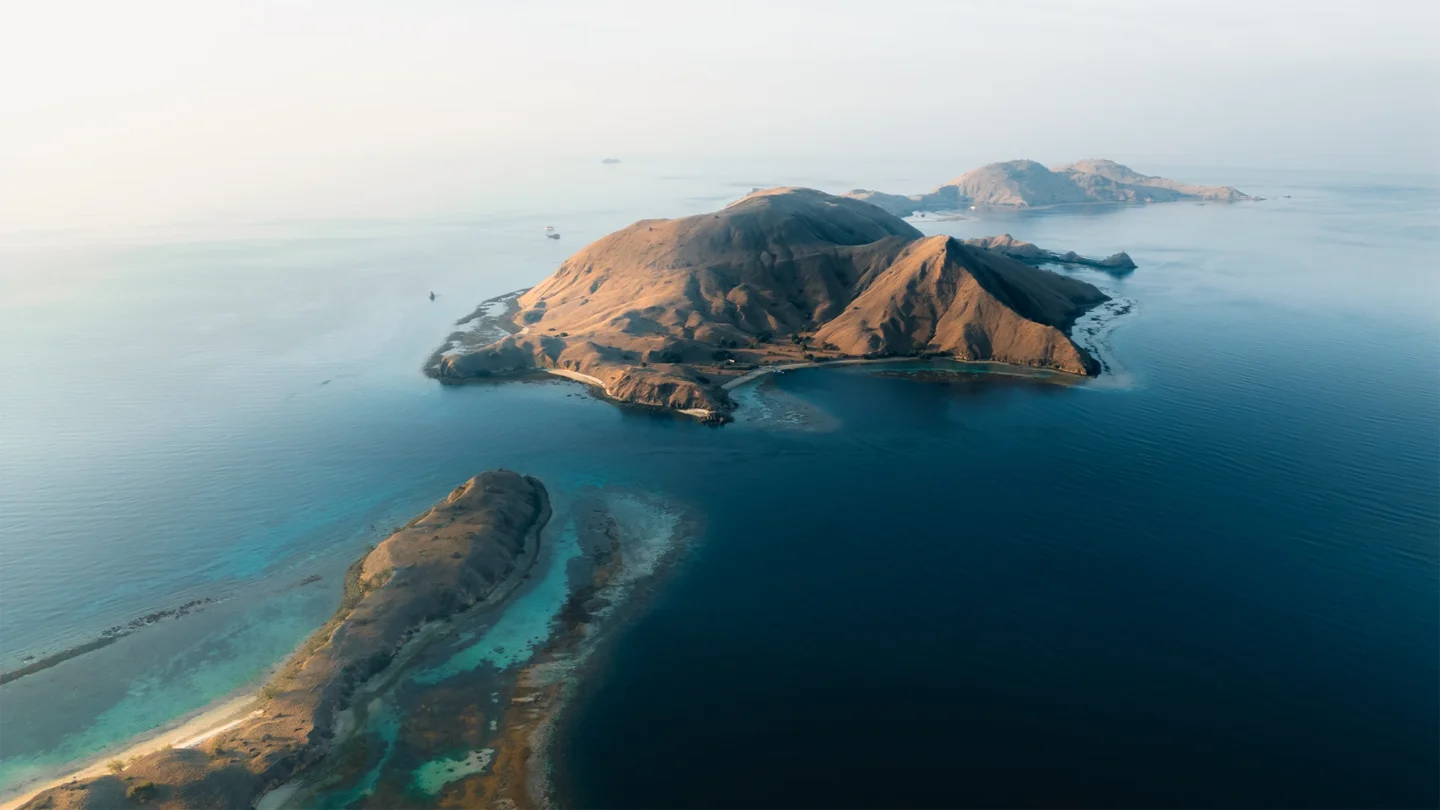
The Golden Passage is a narrow strait that slices between Gili Lawa Darat and the northeastern tip of Komodo Island. This dive site is Well-known for its strong currents and excellent drift diving. The average dive depth ranges from 12 to 25 meters, with the channel bottoming out deeper in some sections.
Divers usually enter on the western side of the channel and drift eastward, though this depends on tidal direction. Proper timing is essential—too early and you’re fighting the current, too late and it turns into a high-speed rollercoaster with poor control and possible down currents near the edges.
Marine Life Highlights
- Pelagics: Giant trevallies, white-tip and black-tip reef sharks, occasional manta rays
- Schooling Fish: Fusiliers, jacks, snapper, batfish
- Reef Life: Hard coral gardens, sea turtles, sweetlips, anthias
- Macro: Nudibranchs, leaf scorpionfish, flatworms in calmer pockets
The site’s rich nutrient flow attracts large biomass, making it one of Komodo’s most dynamic ecosystems. Morning dives often offer better visibility and fewer boats.
What It Feels Like, Diving in Golden Passage
Diving here feels like skydiving underwater. You’re not just diving, you’re being delivered. The current grabs you by the chest and hauls you across an underwater freeway where fish pour past like traffic. At one moment you’re hovering behind a coral head watching a turtle munch on sponge; the next, you’re being shot past a vortex of barracuda like a leaf in a river.
This is Komodo’s energy at full throttle. No surface interval briefing prepares you for that first jolt of current as you drop in. It’s raw, it’s real, and it’s why the Golden Passage is on every seasoned diver’s must-do list.
How to Visit Gili Lawa
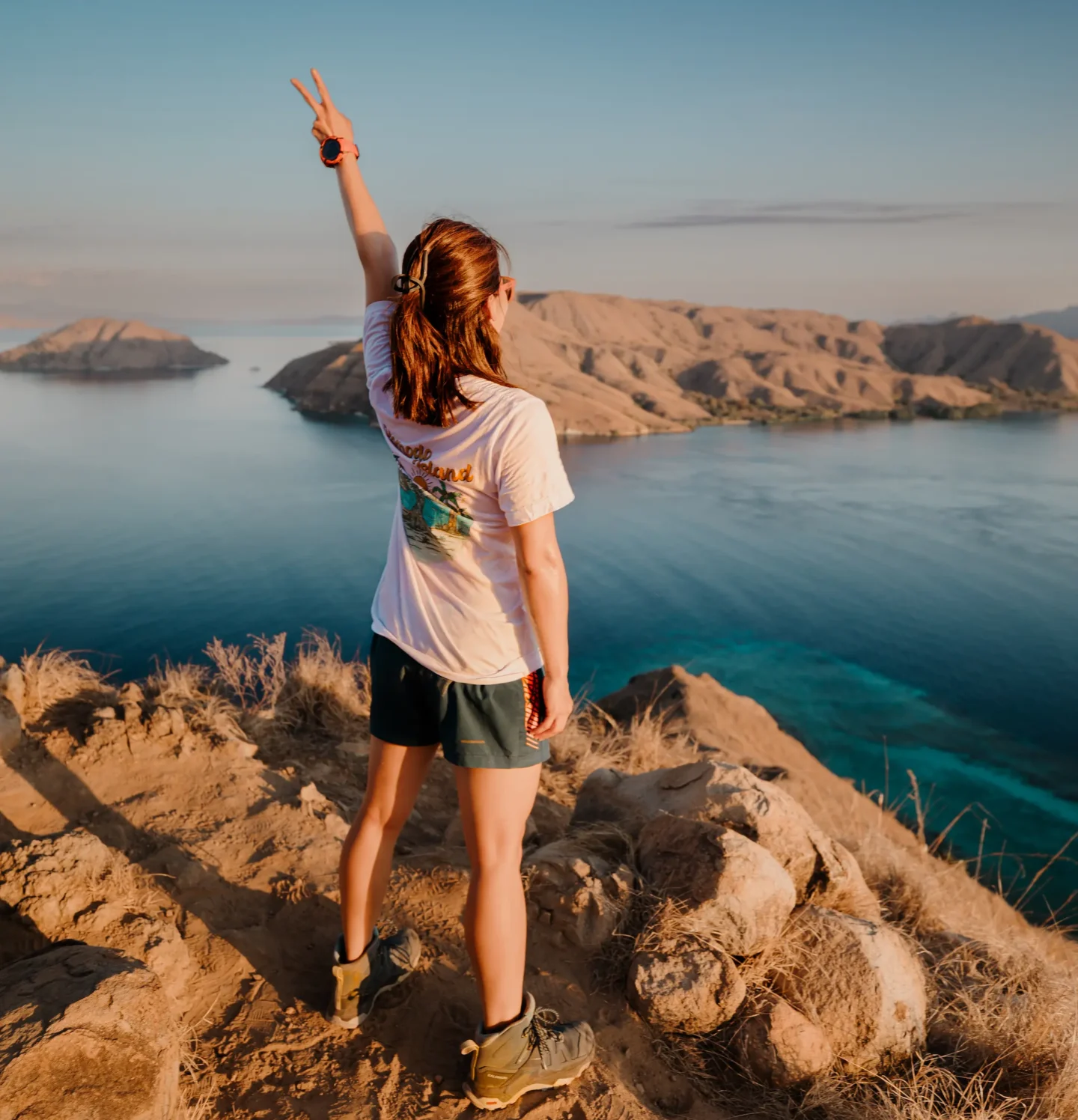
Getting There
Travel Options from Labuan Bajo
Gili Lawa is located in the northern sector of Komodo National Park and is only accessible by boat. The jumping-off point for nearly all visitors is Labuan Bajo, a small port town on the western tip of Flores Island. Labuan Bajo is served by daily flights from major Indonesian cities such as Bali (Denpasar), Jakarta, and Surabaya.
From Labuan Bajo, travelers can reach Gili Lawa via:
- Liveaboard cruises: Multi-day trips ranging from 3 to 7 nights or more. These offer the most comprehensive access to dive sites and snorkeling areas, including Castle Rock, Crystal Rock, and the Golden Passage. We have two itineraries that includes going to Gili Lawa. Check out our Jurassic Komodo (6 Days 5 Nights) and Ultimate Komodo (8 Days 7 Nights).
- Day trips: Technically possible but discouraged due to the distance (3–4 hours one way), limited time on site, and increased environmental impact from high-speed transport.
Liveaboards remain the most practical and rewarding option, especially for divers.
What to Bring and Expect
No Infrastructure: Be Self-Sufficient
Gili Lawa Darat and Gili Lawa Laut have no permanent infrastructure; no shops, no toilets, no food stalls. Everything you need must be brought in and packed out, especially trash.
If you’re stopping here on a liveaboard, your needs will be covered. But if you’re coming by day boats:
- Bring sufficient drinking water (reusable bottle) and snacks
- Carry out all waste (including biodegradable items)
- Respect all park rules and posted guidelines
Clothing, Gear, and Safety Essentials
For trekkers:
- Sturdy shoes or sandals with grip
- Hat, sunglasses, and long sleeves for sun protection
- Small daypack for water and camera gear
- Headlamp or flashlight for sunset hikes
For snorkelers and divers:
- Personal snorkeling or dive gear (if not provided)
- Reef-safe sunscreen and rash guard or wetsuit
- SMB (Surface Marker Buoy), reef hook and dive computer for safety
For a complete checklist on what to bring during your liveaboard trip here, checkout our guide Scuba Diving Liveaboard Checklist.
Komodo’s sun is intense and the terrain is exposed: plan accordingly.
Best Time to Visit
The best time to visit Gili Lawa is June to July, during the dry season. During this period, the seas are calmer, the skies clearer, and visibility underwater is at its best.
- April–June: Lush hills, excellent visibility, fewer boats
- July–September: Dry, golden landscapes; peak tourist season
- October–November: Warmer water, great marine life, less crowded
- December–March: Rainy season, rougher seas, lower visibility
Avoid the rainy season if you’re prioritizing underwater activities or plan to do extensive hiking.
Conclusion
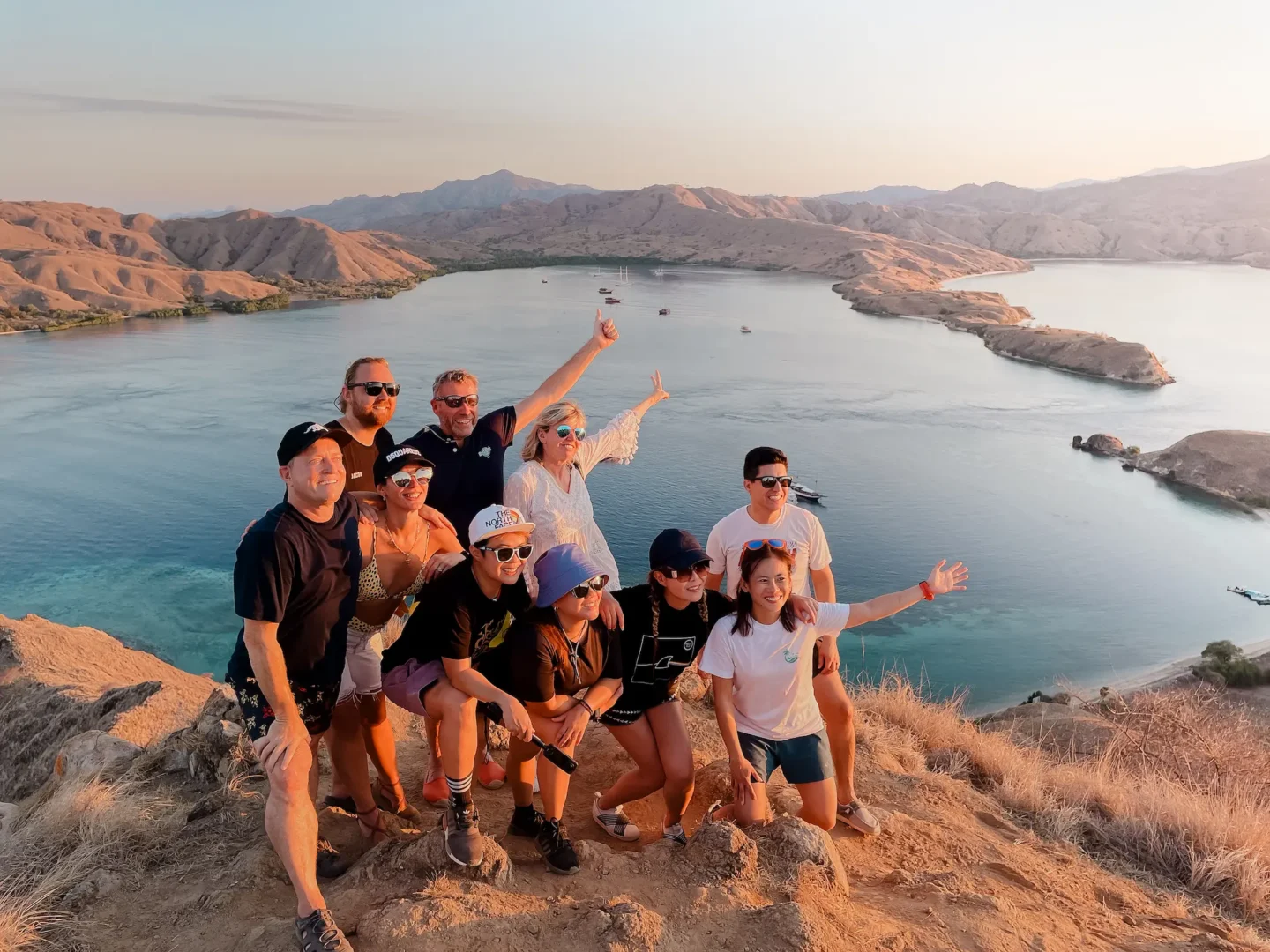
Gili Lawa may not be the headliner in Komodo’s portfolio of natural wonders, but it absolutely holds its own, both above and below the surface. Whether you’re hiking windswept hills for a sunrise that sets your soul straight or dropping into current-fed dive sites teeming with life, these twin islands offer some of the most rewarding experiences in the entire park.
For divers, it’s a playground of adrenaline and biodiversity. For trekkers and photographers, it’s a front-row seat to raw, untouched landscapes. And for everyone who steps foot here, it’s a reminder that real adventure doesn’t come prepackaged, it has to be earned, hill by hill, drift by drift.
But Gili Lawa is also fragile. Its reefs, hills, and wildlife are under pressure from increasing tourism and climate shifts. The trails erode with every careless step; corals bleach from every contact or misplaced fin.
So if you come, and you should, come correct. Bring your respect. Pack out what you bring in. Follow the park rules. And leave this place exactly as wild and extraordinary as you found it.

